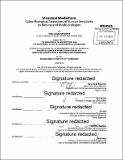Microbial mediations : cyber-biological extensions of human sensitivity to natural and made ecologies
Author(s)
Turgeman, Yaniv Jacob
DownloadFull printable version (23.58Mb)
Alternative title
Designing for sensitivity
Cyber-biological extensions of human sensitivity to natural and made ecologies
Other Contributors
Massachusetts Institute of Technology. Department of Civil and Environmental Engineering.
Advisor
Terry Knight and Eric Alm.
Terms of use
Metadata
Show full item recordAbstract
As natural and human made environments become increasingly monitored and modulated by embedded digital technologies, we are presented with a staggering flow of information reverberating between the scales of the made, the grown, and ourselves. In this thesis, I use two projects as cases for interrogating the material, computational, and biological architecture mediating this information. Common to these projects is the move towards a novel cyber-biological system, which couples physical and digital processes, and utilizes microbiota as natural and programmable agents. I posit that microbes are well suited to mediating between humans and our environments, especially when they are exploited for informing on, or intervening in, phenomena that occur in temporal and spatial scales towards which we are not sensitive. In the thesis, I theoretically frame cyber-biological systems as instantiations of a post-ecological cybernetic vision, collapsing the divide between the made and the natural. As creative interventions, I describe projects designed to provide community and individual access to participate in this hybridized ecology, and suggest future research to explore microbes as sensors, living visualizations, and deployable interventions. The projects I discuss figure the microbiome as an enabling substrate for the extension of our sensitivity to natural ecosystems (Waterfly), the built urban environment (Underworlds), ultimately suggesting a similar extension of sensitivity to our bodies (Everybiome). My analysis of these projects culminates with ideas for future research (Biological Homeostat, Biovisualizations). By exploring realized cyber-biological systems alongside more speculative ones, I establish scientific and technological challenges in their deployment and future development. Through a critical analysis of these projects, I crystallize a design attitude towards creating sensitivity to environments, and juxtapose it with the optimization-oriented problem solving common to the discourse on "responsive" and "smart" environments. Ultimately, I aim to contribute an interdisciplinary synthesis of a scientific paradigm that is emerging between the domains of biological engineering, computation, and the design of our built environment. In promoting new connections between bits, bricks, and biology, I hope to inform contemporary practices of how we design technologies that extend the reach of our senses to the phenomena in our hybridizing made and natural world.
Description
Thesis: S.M., Massachusetts Institute of Technology, Department of Architecture, 2015. Thesis: S.M., Massachusetts Institute of Technology, Department of Civil and Environmental Engineering, 2015. Cataloged from PDF version of thesis. Title as it appears in MIT Commencement Exercises program, June 5, 2015: Designing for sensitivity. Includes bibliographical references (pages 129-139).
Date issued
2015Department
Massachusetts Institute of Technology. Department of Architecture; Massachusetts Institute of Technology. Department of Civil and Environmental EngineeringPublisher
Massachusetts Institute of Technology
Keywords
Architecture., Civil and Environmental Engineering.